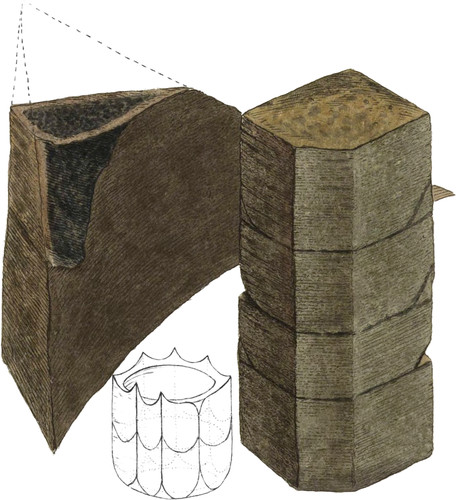 Enlarge
Enlarge
British Mineralogy
Basalt
- Class 2. Earths.
- Ord. 2. Aggregate.
- Syn.
- Laves lithoïdes basaltiques prismatiques. Haüy, Traité, 4. 474.
- Basalt. Emmerl. 1. 339.
- Basalt. Jameson, 1. 369.
- Figurate Trap, Basalt. Kirw. 1. 231.
This substance is remarkable for a formation so peculiar, that, when seen in its most regular appearance, it must leave a lasting impression on every beholder. It is conspicuous in Fingal’s Cave in the Island of Staffa, Scotland, the Giant’s Causeway in the North of Ireland, and in many curious places abroad. There are two excellent prints of the Giant’s Causeway engraved by Vivares, from drawings by Mrs. Drury, to the credit of our own country, which are equal if not superior to any thing of the kind yet executed.
It belongs to the Flœtz-trap formation, according to Geologists, and forms a grand example of distinct concretions in the large way, consisting of columns of from three to nine unequal sides, and often forty feet or more long, placed side by side, either perpendicularly, horizontally, or inclined, sometimes curving, but generally straight; they vary much in size, some being very short and only a few inches in diameter, others approaching two feet. In most of these columns curious transverse divisions are no less conspicuous, forming joints which vary in many ways, apparently depending upon a suite of circumstances difficult to demonstrate, although to be conceived by a mind intelligent, unprejudiced, and attentive to natural phænomena. Although much has been said, I will venture a word or two regarding other stones, that may lead to an easier way of comprehending these in question; and as it seems an approach to crystallization to some, we will endeavour to show its relationship in this particular, because regularity is often the next step lo crystallization. Thus Stalactites, tab. 6, are of particular shapes independent of crystallization, and often finally subside, as it were, with crystallized terminations, &c. But the more earthy ones, such as those from Sunderland, form without crystals, and undulate into funnel forms, see tab. 148; and I have some partly globular, and pressing each other’s sides, making them angular. Thus a combination of a sort of stalactitical globular drops, when compressed, become imitative of the Basalt; and some have conceived a theory of the Basalt forming from globular depositions into beds or strata, while in different states of moisture, which pressing each other and coalescing partially, when dry may govern their separation, I have here figured part of a column of five unequal sides with three transverse divisions, the uppermost of which is 91/2 inches, the middle one 71/2 inches, and the lowest 6 inches in length, and all 91/2 inches wide, showing that they are not regular in length, and the columnar sides are 101/2, 101/2, 12, 81/2, and 6 inches wide, respectively, or thereabouts. The upper one is flatfish at the ends, and has several holes and some cracks visible on the surface in consequence of its being a little decomposed and soft, of a ferruginous brown colour: the base of this joint is a shallow concave segment of a sphere, with a curved truncature on the three corners belonging to the broader sides; the top of the next joint fits the concave of the first by an equal convexity; and the three corners answering to the curved truncature, project where not broken off; and so of the other joint, which also shows in the oblique fracture the fresh appearance and the more ferruginous coat, properly described by Kirwan as a natural change in Basalt on exposure. The projecting corners are at every angle on one end of some joints, either at the top or bottom; and sometimes two joints with projecting corners enclose one without any, which may be convex on both ends. The joints are often very flat. I have two that fit each other, and measure only about three inches each long, and eighteen inches wide, and have nearly even corners. The curved pillars are said to have longer joints and coalesce more closely, so that Sir Joseph Banks and others could not obtain specimens.
Basalt is found in some places in balls, and decomposing with ferruginous crusts like the coating of an onion, showing as I think a probability of the abovementioned theory. It seems to be the latter deposit of decomposed materials from an immense overflow of water. The next plate,

